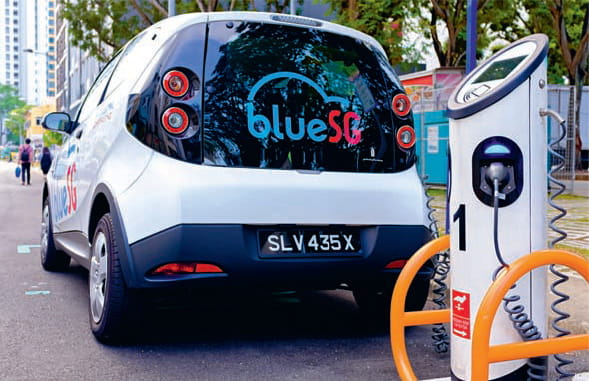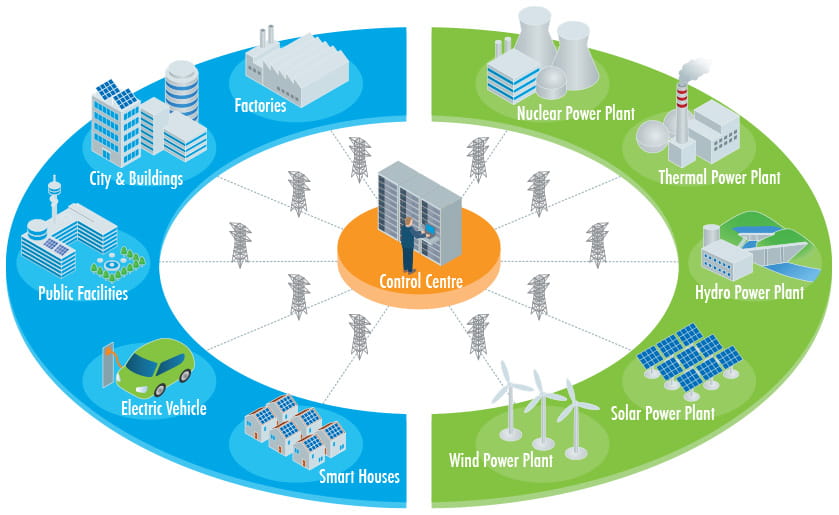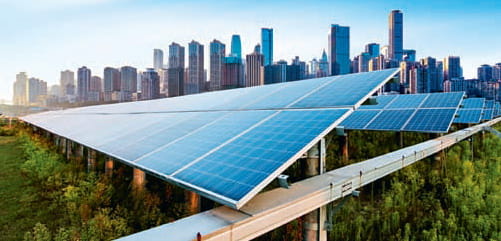Stories > The Future is Green
The Future is Green
From off-grid systems to Internet of Things sensors, exciting technologies and innovative solutions are fuelling the transition to clean energy around the world.
BY TOH EE MING
or the last two years, Dr Sanjay Kuttan, executive director of the Singapore Maritime Institute, has been the proud owner of a plug-in hybrid electric car.
After the day’s work, he leaves his car to charge at a Shell station near his house, walks home to grab dinner and catch up with a TV show, before collecting his fully juiced up car. Now, his car engine burns less fuel during traffic jams, and if he doesn’t switch on the air-conditioner, he can cut back on even more electricity. These lifestyle changes may seem like a hassle to other Singaporeans, but Dr Kuttan views them as incremental – and instrumental – in the larger fight against climate change. He was among the speakers advocating sustainability at the Asia Clean Energy Summit 2019.
Held late last year as part of the Singapore International Energy Week, the annual conference – co-organised by the Sustainable Energy Association of Singapore (SEAS) – brought together more than 3,000 trade visitors and delegates from some 70 countries to discuss their ideas for harnessing clean energy.

To promote greater acceptance of electric vehicles, Singapore is working towards its goal of providing 28,000 EV charging stations at public carparks by 2030 as well as phasing out internal combustion engine vehicles by 2040.
DRIVING A GREEN FUTURE WITH CLEANER VEHICLES
Encouraging the use and adoption of electric vehicles (EV) was one such idea, said Dr Kuttan, who moderated a panel on enabling e-mobility in his capacity as a SEAS council member. Singapore, for instance, has joined the global movement to phase out fossil fuel vehicles and minimise its carbon footprint. A little over 10 years ago, the city-state made major strides by establishing standards for the charging infrastructure ahead of consumer demand.
Specifically, Singapore plans to expand the EV charging infrastructure significantly from 1,600 points today to 28,000 at public carparks islandwide by 2030, while also phasing out internal combustion engine vehicles and have all vehicles run on cleaner energy by 2040.
But while the country is ready for EVs in terms of technology and infrastructure, an uphill battle is expected before electric vehicles can gain greater acceptance among its populace. “I’m not sure if people are willing to make the sacrifices to their daily routine to make that adjustment or even paying a bit more to do the right thing,” opined Dr Kuttan, pointing out that the time needed to power up their vehicles could be seen as a hassle in the efficiency driven country.
“Lifestyle Changes Like Powering Up An Electric Car May Seem Like A Hassle, But May Be Incremental – And Instrumental – In The Larger Fight Against Climate Change.”
Southeast Asia, with its population of 640 million, seems ripe for this shift. According to a 2018 report by the International Renewable Energy Association, the region could have 59 million electric two- to three-wheelers and 8.9 million electric four-wheel vehicles by 2025.
Many potential users of these vehicles come from Thailand and the Philippines, whose governments have been fine-tuning their urbanisation blueprints to be in sync with climate change policies.
Indonesia has set a target of 2.1 million units of two-wheeler electric vehicles and 2,200 units of four-wheel vehicles that will ply its roads by 2025. Homegrown firms that manufacture EVs – like Malaysia’s Proton and Vietnam’s Vinfast – are also sprouting up in the region.
CUTTING ONE CABLE AT A TIME
The shift from bigger, larger capacity sources to smaller, more distributed ones was another idea that was explored at the summit. With countries making a switch to wireless networks, a decreasing reliance on power lines, utility poles, or expensive transformers and underground cables is to be expected.
Local company TransferFi, for instance, aims to create the world’s first long-range, safe and efficient Wireless Power Network. The technology paves the way for smart cities and buildings to become a reality when it is used to power Industrial Internet of Things sensors more efficiently.
Aashish Mehta, co-founder and CEO of TransferFi, said the summit gave it a “new perspective” of the strong drive towards sustainability, net zero cities, and moving the human race forward in the way we use energy. However, he noted the challenges involved in adopting such new technologies, amid the prevalent use of wiring and batteries.
“Few people realise that the time and costs involved in traditional methods of mass sensor deployments are not sustainable and scalable,” he said. “We see a world of distributed sources of energy, untethered from cabling infrastructure where anyone can have access to power from anywhere and anytime.”

A graphic representation of wireless power network, a relatively new technology that eliminates the installation of expensive cabling infrastructure. It is expected to become one of the core features of smart cities on a macro level and smart buildings on a micro level.
In the past couple of years, more companies have set up shop in the Asia- Pacific region – which holds 40 per cent of the market share of revenue generated by the wireless energy sector worldwide – to fuel growing demand. They include WiTriCity, a firm in Massachusetts, the US, founded by MIT professor Marin Soljacic and Taiwan-based JJPlus.
GETTING POWER FROM THE SUN
Harnessing solar power remains a key focus for the clean energy sector in Asia, while providing new growth opportunities in Southeast Asia’s energy landscape.
According to SEAS executive director Kavita Gandhi, mini-grids can potentially provide electricity to some 50 million people by 2030.

The potential of solar energy is increasingly being explored in countries throughout Asia including China’s Chongqing city.
The Philippines has recently completed a 2 megawatt-peak solar-battery micro grid project in Mindoro province – touted to be the largest of its kind in the region – to provide uninterrupted electricity supply throughout the year in other off-grid areas.
Singapore, too, views solar energy as its most viable renewable energy option, given especially the city-state’s limited access to geothermal, wind and tidal power.
The country has plans to ramp up its solar capacity by more than seven times from current levels and increase installed solar capacity to 2 gigawatt-peak. This will involve maximising the deployment of solar panels onto available surfaces, including rooftops and reservoirs, offshore and on the vertical surfaces of buildings – and has the added benefit of freeing up land space.
In the works is a 50 megawatt-peak floating solar photovoltaic system on Singapore’s Tengeh Reservoir. When completed in 2021, it will be one of the largest of its kind in the world, and will eliminate the emission of 28,000 tonnes of carbon dioxide every year – equivalent to taking 6,000 cars off Singapore’s roads. Kept at cooler temperatures by evaporating water from the reservoirs, these floating systems are able to generate energy more efficiently than land-based ones.
Noting the drastic cost of renewables in the last decade, Gandhi is confident that the adoption and deployment of clean energy will hasten the acceleration of Asean’s renewable energy potential.
|
CHAMPIONING RENEWABLE ENERGY Initiatives around the world that incentivise individuals to join the clean energy movement. |
|||
|
CHINA |
|||
|
GERMANY |
|||
|
KENYA |
|||
|
ITALY |
|||
|
URUGUAY |
|||
